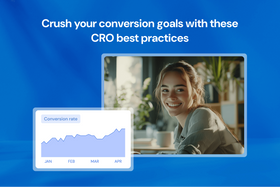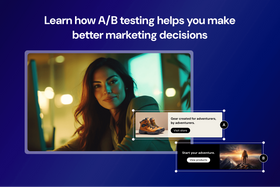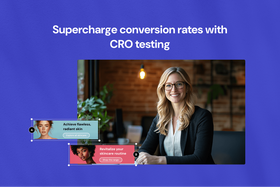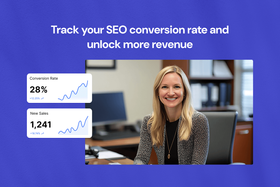Conversion rate optimization: The ultimate guide
Discover the fundamentals of conversion rate optimization, how to build an effective CRO strategy, and which key metrics to monitor for success.
Updated May 12, 2025
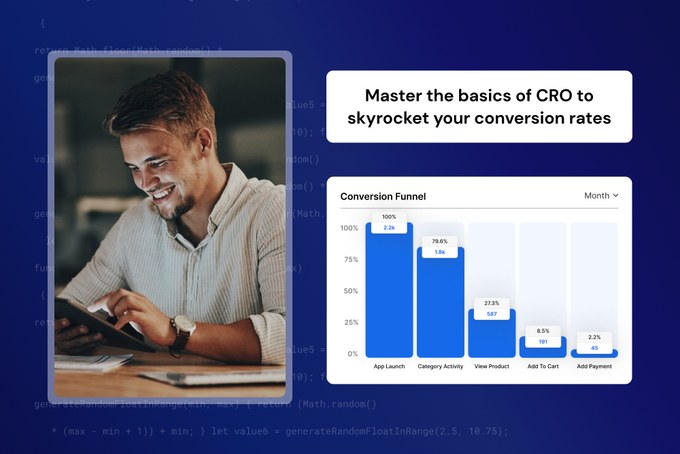
Conversion rate optimization (CRO) is essential for businesses aiming to make the most of their website traffic. By increasing the percentage of visitors who take desired actions, such as making a purchase or signing up for a newsletter, CRO helps turn your traffic into tangible results. Through careful analysis, testing, and data-driven adjustments, CRO ensures each interaction and user journey is optimized, boosting overall revenue and return on investment (ROI).
Key takeaways
- The goal of every experiment is to learn. Don't be afraid of failure; you never fail if you learn.
- Use the minimum budget required to learn what works and what doesn't to avoid unnecessary expenses.
- There's software available for most types of CRO, so there's no need to develop your own.
- To optimize, you must measure. Without measurement, you can't understand or improve CRO.
What is conversion rate optimization?
CRO is the process of enhancing a site or web page to increase the percentage of visitors who complete a desired action. A desired action, also known as a conversion, can be anything from making a purchase, signing up for a newsletter, filling out a form, or booking a demo. CRO involves analyzing user behavior, testing different elements, and making data-driven changes to improve user experience and increase conversions.
» Simplify conversion rate optimization with AI.
CRO vs. SEO
While both CRO and SEO aim to improve a website's performance, they have different purposes:
- SEO increases website visibility in search results to attract more organic traffic.
- CRO turns that traffic into customers by optimizing the website to encourage conversions.
However, CRO and SEO are not mutually exclusive. In fact, they work well together. SEO brings more visitors to your site, and CRO ensures those visitors are more likely to convert.
Why is CRO important?
CRO is essential for websites with significant traffic that can convert sales online, especially if you're investing in driving more traffic. Improving your conversion rates, even by small percentages, directly increases your revenue. You're already spending effort and money to attract visitors, so converting them at a higher rate will maximize the return on that investment even more.
With that in mind, some of the benefits of CRO include:
- Higher conversion rates
- Increased revenue
- Better ROI
- Data-driven decision making
- Finding high-performing and underperforming channels
- Identifying opportunities to reduce costs
READ MORE: How to calculate and optimize SEO conversion rate
Key CRO challenges
While CRO can significantly benefit any business, it also comes with its own set of challenges. Depending on your business, these challenges might include:
- Not having enough data: As we often say in marketing, "If you can't measure it, don't build it." Good tracking is the most basic requirement for CRO. Without the necessary data, you can't get accurate insights and make well-informed decisions.
- Having too much data: While having enough data is important, too much data can be problematic if you don't know what to focus on. While it's good to measure everything, you should concentrate on the most relevant data rather than trying to analyze all of it.
- Not having enough traffic: Because CRO typically relies on observing user behavior without much direct interaction, you need a good amount of traffic to evaluate and optimize your conversion funnel properly.
- Clearly communicating your value proposition: Your target audience needs to understand why your product is right for them. This often involves creating a smooth user experience with little to no friction or distractions, especially for products that require information during the consideration or onboarding process.
- Creating trust: People often prefer buying from familiar brands, so establishing trust with your audience is essential. You need to provide social proof or various trust signals, such as customer testimonials, case studies, and user reviews.
- No data-driven culture within a company: Some organizations rely more on subjective feelings or opinions rather than data when making decisions.
- Multi-touch attribution: When users interact with a brand through multiple channels, it becomes difficult to determine which touchpoint should get credit for a conversion.
- Selecting the right software: Depending on your specific needs, choosing the right CRO tools can be challenging. Different tools have different strengths. Plus, not all CRO software is plug-and-play and requires a complex integration process.
How to build a winning CRO strategy in 5 steps
Developing a successful CRO strategy requires an approach that focuses on the user journey and is tailored to your business. Let's look at the steps you need to follow to optimize for conversions.
» Discover proven conversion strategies to boost sales and ROI.
1. Define your funnel
To define your funnel, ask yourself:
- What product am I selling?
- What journey do users go through?
- Where does my traffic come from? Is it ads, social media, organic search, or SEO?
Focus on one channel and make sure you can generate enough traffic from that source without breaking the bank. This will set the foundation for your CRO strategy.
» Generate a greater ROI across multiple channels with Entail. Book a consultation to find out how.
2. Decide where your traffic should go
Next, decide where you want to direct that traffic. Map out the journey you want users to take to reach the desired destination while ensuring you can track each step. Make the messaging at each stage clear and concise, and use compelling calls to action (CTAs) throughout the journey to guide users toward your conversion goal.
» Create highly relevant CTAs to guide users through your conversion funnel. Start free.
3. Form hypotheses based on data
Before you can start optimizing, you need to generate hypotheses about what changes might improve your conversion rates. These hypotheses should be based on data and insights gathered from user behavior and analytics. For example, if you notice a high drop-off rate on your sign-up page, you might hypothesize that simplifying the form will increase completion rates.
4. Start testing your hypotheses
Once you have your hypotheses, it's time to prove or disprove them. Make changes based on your hypotheses and use A/B testing to compare the new version against the original to see which version performs better.
When you test, use the minimum budget required because most tests fail. The money you spend is not for succeeding but for learning. That should be your goal. Once you've learned what works and have a funnel that makes money, you can scale up your budget. This is the essence of CRO: form an assumption, test it quickly and inexpensively, and then double down on what works.
5. Monitor and re-evaluate your strategy
After implementing changes, regularly review the results to see how they impact your conversion rates. Use these insights to refine your approach. By consistently assessing and adjusting your strategy, you can adapt to new trends and user behaviors, maximizing your conversion potential over time.
How often you re-evaluate your strategy depends on your capacity and budget. But at the very least, try to check on each channel daily.
CRO metrics and KPIs to monitor
The exact SEO and conversion metrics you need to track will vary based on your website and the type of product or service you offer. However, you can monitor the following to measure the effectiveness of your CRO efforts:
- Volume: Total amount of potential visits to your website, representing the pool of customers you could convert.
- Impressions: How often users see your content, ads, or search results, indicating the visibility of your content and the potential reach of your campaigns.
- Traffic: The number of visitors coming to your website from various sources such as organic search, paid ads, social media, and direct visits.
- Click-through rate (CTR): The percentage of impressions that result in clicks. A high CTR indicates that users find your content valuable and are motivated to take action.
- CTA conversions: How many users complete a desired action after clicking a CTA. This metric directly measures the effectiveness of your CTAs in driving user actions that lead to conversions.
- Customer acquisition cost (CAC): The total cost of acquiring a new customer. This metric helps you evaluate the efficiency and profitability of your marketing strategies.
- Average order value (AOV): The average amount customers spend per transaction. This metric helps you understand purchasing behavior and identify opportunities to increase revenue.
- Revenue per visitor (RPV): The average revenue generated from each visitor. This metric provides insights into the overall effectiveness of your CRO strategies.
- Cost per conversion: The average cost incurred to achieve a single conversion. This metric helps you assess the efficiency of your marketing campaigns and optimize your budget to maximize ROI.
- Customer lifetime value (CLV): The total estimated revenue a business can expect from a single customer over their entire relationship. This metric helps you understand long-term profitability and informs strategies to retain and nurture high-value customers.
- Interactions per visit: The number of actions a user takes during a single visit to your website. This metric indicates how well your website encourages meaningful interactions that lead to conversions.
- Revenue growth: The increase in revenue over a specific period. This metric indicates the overall health and success of your business.
- Churn rate: The percentage of customers who stop using your product or service over a specific period. This metric helps you identify and reduce the factors contributing to customer churn.
» Learn how to track and maximize SEO conversions.
Proven CRO strategies and best practices
CRO can be challenging, and businesses often struggle with it, but here are the techniques I've found to be most useful.
» Discover even more CRO best practices to boost conversions.
Prioritize the user journey
If you're doing CRO for organic search, keep the user journey and its stages in mind. You need to find users with the right intent and guide them through their journey from the top to the bottom of the funnel using highly relevant CTAs. Make sure you understand the user and provide the best next step to support their journey and create an effective conversion funnel.
» Learn more about conversion paths and how to create them.
Be specific about your value proposition
A common mistake I see businesses make is using vague value propositions. To stand out in today's saturated market, your message and value propositions must be very specific. Your optimization efforts must be tailored to each channel, value proposition, template, and product. Specificity is key to cutting through the noise and effectively reaching your target audience.
Make learning your goal
When conducting an experiment, your primary objective should be to learn, not to succeed. Success means you've been able to either prove or disprove your assumption as quickly and inexpensively as possible. The only way to fail is by not learning from the results. Each experiment, regardless of its outcome, contributes to your understanding and helps refine your strategy.
Optimize each step separately
CRO involves multiple steps of the customer journey, from awareness to purchase. In e-commerce, for instance, this includes website visits, product selection, adding to cart, and checking out. Each step has the potential for user drop-off. To effectively optimize conversion rates, focus on improving each step separately.
» Explore proven techniques to increase sales with e-commerce CRO.
For example, work on increasing the percentage of users who move from the collection page to a product page, then those who add items to their cart, proceed to checkout, and complete their purchase. This step-by-step approach allows for targeted improvements throughout the entire conversion funnel.
» Explore winning content marketing strategies for e-commerce.
Always keep the bottom of the funnel in mind
Having said that, you also need to consider the overall impact of your optimizations on the final conversion goal. If you focus on one step at a time, you may improve a single step while negatively affecting what happens at the bottom of the funnel. Therefore, while focusing on individual steps, always monitor the entire funnel to ensure improvements at one stage don't harm later stages or the final conversion rate.
» Learn how to get customers to take action at the bottom of the marketing funnel.
Don't be afraid to test the unconventional
You should test ideas that seem unconventional or even a bit crazy. Many successful inventions weren't always logical or conservative. Of course, it's important to protect your brand, but don't be afraid to think outside the box. For example, when testing, use six variations, including two that seem a little offbeat, just to see what happens. You might find something new and interesting along the way.
Supercharge CRO by prioritizing the user journey
At its core, CRO is about understanding and supporting user needs at every touchpoint. By prioritizing the user journey, you help users find exactly what they need and create a satisfying experience while driving conversions. Each step you take to optimize the user journey translates into better engagement, higher conversion rates, and, ultimately, increased revenue.
» Book a demo to see Entail's CRO software in action, or try it for free.
